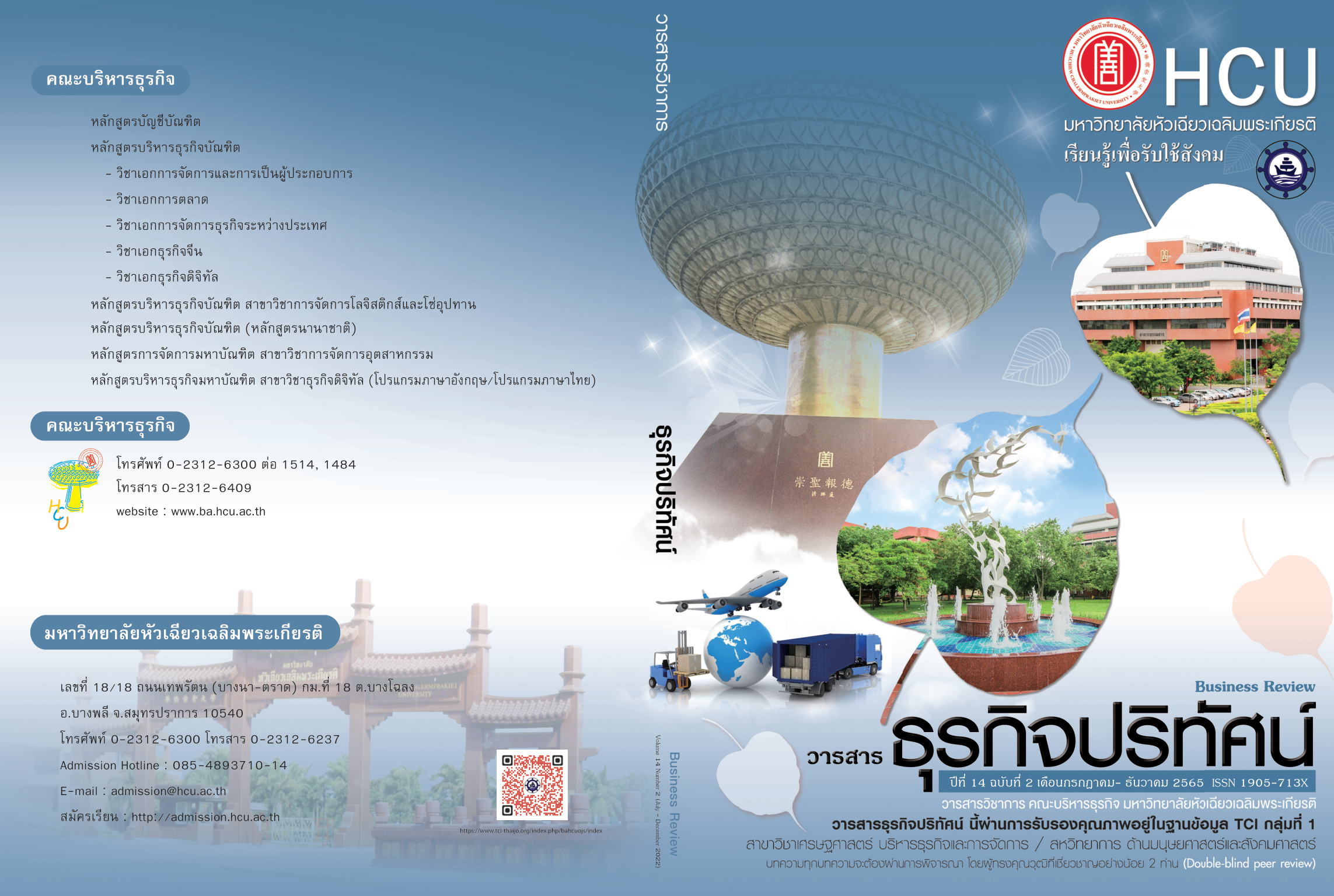Performance of Dollar-Cost Averaging Using Internal Rate of Return on Mutual Fund Investment
Keywords:
Mutual Fund, Dollar-Cost Averaging, Lump Sum InvestmentAbstract
Dollar-Cost Averaging has been popular as an investment strategy in mutual fund for new investors who may lack of time nor knowledge to monitor their portfolio. The principle of Dollar-Cost Averaging strategy is to buy a fixed amount of an investment at regular interval irrespective of its price. This study investigates the Internal Rate of Return between two trading strategies; the Dollar-Cost Averaging and the Lum Sum Investment. Also, the study examines the performance of fund management identified by Sharpe Ratio, Treynor Ratio and Jensen's Alpha measurement. The results show that Lum Sum Investment provides a yield curve in the same direction as the SET TR Index while the Dollar-Cost Averaging's yield is based on the price trend scheduled on a certain date and market timing rather than investment periods. However, the high performance of fund management makes return on Dollar-Cost Averaging strategy gets closer to the return index due to more investment frequency.
References
จิรัตน์ สังข์แก้ว. (2547). การลงทุน. พิมพ์ครั้งที่ 6. กรุงเทพมหานคร: สำนักพิพ์มหาวิทยาลัยธรรมศาสตร์.
ชูชีพ พิพัฒน์ศิถี. (2540). เศรษฐศาสตร์การวิเคราะห์โครงการ. พิมพ์ครั้งที่ 3. กรุงเทพมหานคร: สำนักพิมพ์มหาวิทยาลัยธรรมศาสตร์.
ตลาดหลักทรัพย์แห่งประเทศไทย. (2558). Your First Stock. สืบค้นเมื่อ 2 กุมภาพันธ์ 2562, จาก Yuanta เว็บไซต์: https://www.set.or.th/yourfirststock/pdf/dca.pdf.
ตลาดหลักทรัพย์แห่งประเทศไทย. (2560). ราคาดัชนีผลตอบแทนรวม. สืบค้นเมื่อ 10 มีนาคม 2562, จากตลาดหลักทรัพย์แห่งประเทศไทย เว็บไซต์: https://www.set.or.th/th/market/tri.html.
นภัสนันท์ บรัศไพบูลย์ และสุรชัย จันทร์จรัส. (2559). การศึกษาความสัมพันธ์ระหว่างประสิทธิภาพการดำเนินงานของกองทุนรวมในประเทศไทยและอัตราผลตอบแทนเฉลี่ยโดยเปรียบเทียบกับความเสี่ยง. วารสารการจัดการสมัยใหม่, 14(1), 41-50.
สมาคมบริษัทจัดการกองทุน. (2560ก). ดัชนีอ้างอิงมาตรฐาน. สืบค้นเมื่อ 15 กุมภาพันธ์ 2562, จากสมาคมบริษัทจัดการลงทุน เว็บไซต์: http://oldweb.aimc.or.th/performance.html.
สมาคมบริษัทจัดการกองทุน. (2560ข). มูลค่าสินทรัพย์สุทธิของอุตสาหกรรมจัดการลงทุนเทียบกับมูลค่าหลักทรัพย์ตามราคาตลาดหลักทรัพย์. สืบค้นเมื่อ 5 พฤษภาคม 2562, จากการจัดการการเงิน การลงทุน การศึกษาความเป็นไปได้ทางธุรกิจ เว็บไซต์ http://oldweb.aimc.or.th/24_overview_detail.php?nid=34&subid=0&ntype=1.
สรศาสตร์ สุขเจริญสิน และปริยดา สุขเจริญสิน. (2556). ความสม่ำเสมอของผลการดำเนินงานของกองทุนรวมตราทุนในประเทศไทย. วารสารเศรษฐศาสตร์ปริทรรศน์ สถาบันบัณฑิตพัฒนบริหารศาสตร์, 7(2), 102-132.
Brennan, M. J., Li, F., & Torous, W. N. (2005). Dollar cost averaging. Review of Finance, 9(4), 509-535.
Constantinides, G. M. (1979). A note on the suboptimality of dollar-cost averaging as an investment policy. Journal of Financial and Quantitative Analysis, 14(2), 443-450.
Dichtl, H., & Drobetz, W. Dollar-cost averaging and prospect theory investors: An explanation for a popular investment strategy. Journal of Behavioral Finance, 12(1), 41-52.
Himawan, A. (2010). Daily portfolio investment return analysis with dollar cost averaging method. Business and Entrepreneurial Review, 9(2), 151 -163.
Lai, H. C., Tseng, T. C., & Huang, S. C. (2016). Combining valueaveraging and bollinger band for an ETF trading strategy. Applied Economics, 48(37), 3550-3557.
Leggio, K. B., & Donald, L. (2001). Does loss aversion explain dollar-cost averaging? Financial Services Review, 10(1-4), 117-127.
Marshall, P. S. (2000). A Statistical comparison of value averaging vs dollar cost averaging and random investment techniques. Journal of Financial and Strategic Decisions, 13(1), 87-99.
Paglia, J. K., & Xiaoyang, J. (2006). Implementing a dollar cost averaging investment strategy: Does the date of the month matter? The Journal of Wealth Management, 9(2), 54-62.
Panyagometh, K., & Zhu, K. X. (2016). Dollar-cost averaging, asset allocation, and lump sum investing. The Journal of Wealth Management, 18(4), 75-89.
Shtekhman, A., Christos, T., & Brian, W. (2012). Dollar-cost averaging just means taking risk later. Retrieved February 10, 2020, from Vanguard research Website: https://passiveinvestingaustralia.com/downloads/Dollar-Cost-Averaging-Just-Means-Taking-Risk-Later-Vanguard.pdf.
Wu, Y. L., Yang, P. C., & Lin, J. Y. (2009). The study of the rate of returns' difference for local funds' dollar-cost averaging three times per month. Journal of Information and Optimization Sciences, 30(4), 779-798.
Downloads
Published
How to Cite
Issue
Section
License
Copyright (c) 2022 Business Review Journal

This work is licensed under a Creative Commons Attribution-NonCommercial-NoDerivatives 4.0 International License.
All articles published in the Business Administration and Management Journal Review are copyrighted by the journal.
The views and opinions expressed in each article are solely those of the individual authors and do not represent those of Huachiew Chalermprakiet University or any other faculty members. Each author is fully responsible for the content of their own article. Any errors or issues found are the sole responsibility of the respective author.




